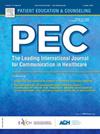整合病人教育的理论与实践建构:一个全面的范围检讨
IF 2.9
2区 医学
Q2 PUBLIC, ENVIRONMENTAL & OCCUPATIONAL HEALTH
引用次数: 0
摘要
本研究系统地对现有理论、模型和其他患者教育结构中的患者教育概念进行分类、综合和映射,以阐明其概念基础并解决该领域的关键挑战。方法遵循乔安娜布里格斯研究所(JBI)的指导方针,我们使用PCC(人口,概念,背景)框架进行了范围审查。通过Scopus、Web of Science、CINAHL、PubMed和Embase进行系统搜索。两位审稿人独立筛选标题、摘要和全文,以确定符合条件的研究。包括定义了患者教育理论、模型、方法或策略并描述了实际应用的出版物。数据提取遵循结构化形式,并使用PAGER框架合成证据。定向内容分析,结合分类矩阵和开放编码,确定了患者教育结构的模式。研究结果被综合成一个由输入-过程-输出(IPO)框架构成的概念图。结果在25649篇筛选文章中,56项研究符合纳入标准。分析揭示了七个关键类别:(1)变革性患者教育周期;(2)社会互动、学习和支持周期;(3)教育与患者的适应;(4)教育者的能力和角色;(5)患者教育材料;(6)促进信息处理;(7)程序和过程导向方法。13个子类别进一步描述了患者教育策略。综合概念图将这些结构整合到三个核心维度:基本先决条件(输入)、适应性和个性化教育过程以及患者转化结果(输出)。结论本研究突出了患者教育结构的广泛性、复杂性和多面性。通过将不同的理论和实践方法整合到一个综合框架中,它提高了概念的清晰度,并为未来的实证验证提供了基础。实践意义本研究全面绘制了患者教育建构图,为构建整合的理论模型奠定了基础框架。由此产生的分类对于构建可适应各种医疗保健环境的全面患者教育模型至关重要。本文章由计算机程序翻译,如有差异,请以英文原文为准。
Integrating theoretical and practical constructs in patient education: A comprehensive scoping review
Objectives
This study systematically categorizes, synthesizes, and maps patient education concepts within existing theories, models, and other patient education constructs to clarify its conceptual foundations and address key challenges in the field.
Methods
Following Joanna Briggs Institute (JBI) guidelines, we conducted a scoping review using the PCC (Population, Concept, Context) framework. A systematic search was performed across Scopus, Web of Science, CINAHL, PubMed, and Embase. Two reviewers independently screened titles, abstracts, and full texts to identify eligible studies. Included publications defined patient education theories, models, methods, or strategies and described practical applications. Data extraction followed a structured form, and evidence was synthesized using the PAGER framework. A directed content analysis, incorporating categorization matrices and open coding, identified patterns in patient education constructs. Findings were synthesized into a conceptual map structured by the Input-Process-Output (IPO) framework.
Results
From 25,649 screened articles, 56 studies met the inclusion criteria. Analysis revealed seven key categories: (1) Transformative patient education cycle, (2) Social interaction, learning, and support cycle, (3) Adaptation of education with the patient, (4) Educator competencies and roles, (5) Patient education materials, (6) Facilitating information processing, and (7) Procedural and process-oriented approaches. Thirteen subcategories further delineated patient education strategies. The synthesized conceptual map integrates these constructs into three core dimensions: Essential Prerequisites (Input), Adaptive and Personalized Education Process, and Patient Transformation Outcomes (Output).
Conclusions
This study highlights patient education constructs' breadth, complexity, and multifaceted nature. By consolidating diverse theoretical and practical approaches into an integrated framework, it enhances conceptual clarity and provides a foundation for future empirical validation.
Practice implications
This study comprehensively maps patient education constructs, establishing a foundational framework for developing an integrated theoretical model. The resulting categorizations are essential for constructing a comprehensive patient education model that can be adapted to various healthcare contexts.
求助全文
通过发布文献求助,成功后即可免费获取论文全文。
去求助
来源期刊

Patient Education and Counseling
医学-公共卫生、环境卫生与职业卫生
CiteScore
5.60
自引率
11.40%
发文量
384
审稿时长
46 days
期刊介绍:
Patient Education and Counseling is an interdisciplinary, international journal for patient education and health promotion researchers, managers and clinicians. The journal seeks to explore and elucidate the educational, counseling and communication models in health care. Its aim is to provide a forum for fundamental as well as applied research, and to promote the study of organizational issues involved with the delivery of patient education, counseling, health promotion services and training models in improving communication between providers and patients.
 求助内容:
求助内容: 应助结果提醒方式:
应助结果提醒方式:


